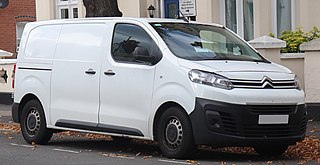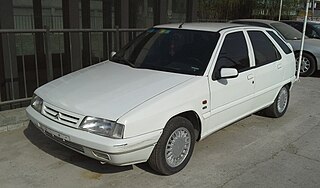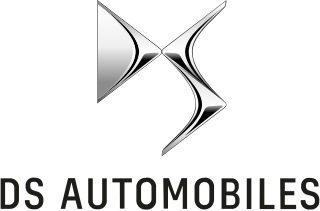
The Citroën C3 is a supermini car (B-segment) produced by Citroën since April 2002. It replaced the Citroën Saxo in the model line up, and is currently in its fourth generation. Initial models of the Citroën C3 were built using the same platform as the Peugeot 206. The third generation model was released in January 2017, and has been developed alongside the Peugeot 208 since 2019.

The Citroën Berlingo and Peugeot Partner are a range of vans produced since 1996 and marketed under the Citroën and Peugeot marques. They are sold as light commercial vehicles or as a passenger multi-purpose-vehicle variant with rear seats and windows. They were initially a product of the French PSA Group, which later became part of the multinational Stellantis conglomerate. The third generation has also been sold under the Opel and Vauxhall Motors marques as the Combo, by Toyota as the Proace City from 2019, and by Fiat as the Doblò from 2022.

The Peugeot 307 is a small family car produced by the French automaker PSA Peugeot Citroën under their Peugeot marque, from 2001 to 2008 in Europe, and was the successor to the Peugeot 306, which was discontinued in 2002 after being in production for nine years. Using the PSA PF2 platform, it was awarded the European Car of the Year title for 2002, and continued to be offered in China and certain South American markets through 2014, despite the September 2007 French launch of the 308, which is built on the same platform.

The Citroën Xsara is a compact C-segment family car, produced by the French automaker PSA Peugeot Citroën, under their Citroën marque, from 1997 to 2006. The Xsara was a development of the Citroën ZX and Peugeot 306, which shared a platform and running gear.

The Citroën C4 is a car produced by Citroën, part of Stellantis. It was positioned to be the successor to the Citroën Xsara. The first generation production started in September 2004. For its first two generations, the C4 was a compact car/small family car, but it has been redesigned as a subcompact crossover SUV for its third generation.

The Citroën Jumpy is a light commercial van jointly developed by FCA Italy and PSA Group, and mainly manufactured by Sevel, a joint venture between the two companies since 1994. The Jumpy was also sold as the Peugeot Expert and Fiat Scudo beginning in 1995.

The Peugeot 207 is a supermini car (B) that was designed and produced by the French automaker Peugeot from 2006 to 2014. It was presented at the Geneva Motor Show in 2006, and entered production in April 2006, as the successor to the Peugeot 206. It shares the same platform with the Citroën C3.
Dongfeng Peugeot-Citroën, formerly Dongfeng Peugeot-Citroën Automobile Co., Ltd. (DPCA) from 1992 to 2021, is an equally owned Chinese joint venture between the automobile manufacturers Dongfeng Motor Corporation and Stellantis. Based in Wuhan, capital of Hubei province, it manufactures Peugeot and Citroën models for sale in China.

The Citroën Fukang or Dongfeng Fukang is a series of compact vehicles available in a variety of body styles. It was the first in a range of cars produced for the Chinese market by the Dongfeng Peugeot-Citroën Automobile group, a joint venture between the French PSA Peugeot Citroën and Chinese manufacturer Dongfeng Motor Corporation.

The Eurovans are a family of passenger automobiles from the Citroën, Peugeot, Fiat and Lancia marques that were produced at the jointly owned Sevel Nord factory in France. The term Eurovan was not used by the brands themselves in sales literature, but rather by the motoring press to refer to the vans collectively. It was launched in March 1994, and production ceased in November 2010 for the Fiat and Lancia models, and in June 2014 for the Citroën and Peugeot siblings. They are considered to be large MPVs.

The Peugeot 308 is a small family car produced by French automobile manufacturer Peugeot. It was unveiled in June 2007, and launched in September 2007 in hatchback form, which was followed by station wagon in March 2008, coupé cabriolet in February 2009, and a sedan version in February 2010. The 308 replaced the 307, and positioned below the 508 and above the smallest 208.

The Citroën C4 SpaceTourer, also spelled Citroen C4 SpaceTourer in some other languages, is a five-seater car produced by French manufacturer Citroën with a seven-seater version called the Grand C4 SpaceTourer also available. It has a five-door compact multi-purpose vehicle (MPV) bodystyle. The seven seat Grand C4 Picasso made its debut first, at the Paris Motor Show in September 2006, with the five seat version following in January 2007.

The Citroën C3 Picasso is a car produced by the French motor company Citroën from 2008 to 2017. It has a five-door mini MPV design and was first unveiled at the 2008 Paris Motor Show as a concept car named "Drooneel". The Picasso is the mini MPV version of the Citroën C3 and the successor of the Citroën Xsara Picasso, and was designed to compete with the Opel Meriva, Nissan Note, Renault Modus and Ford Fusion.

The DS 3 is a luxury supermini initially produced by the French automobile manufacturer Citroën and officially launched in January 2010. Positioned below the DS 4, this was the first and entry-level model from the DS premium sub-brand, which was spun-off in 2016 into DS Automobiles.

The DS 4 is a subcompact executive car, and it is the second model in the luxury DS sub-brand created by Citroën, now an independent brand. Starting in 2021, it is currently in its second generation, which is based on an all-new EMP2 platform shared with the Opel Astra L and Peugeot 308 III. As of 2023, it is currently slotted above the DS 3 and below the DS 7 Crossback.
France was a pioneer in the automotive industry and is the 11th-largest automobile manufacturer in the world by 2015 unit production and the third-largest in Europe. It had consistently been the 4th-largest from the end of World War II up to 2000. It is 16% of sales of French manufactured products.

The Stellantis Trnava Plant is a major car plant in Slovakia and the most recently established Stellantis plant in Europe. It is located directly to the south-east of Trnava, approximately 60 kilometres (37 mi) from Bratislava and the frontier with Austria to the south-west.

DS Automobiles is a French luxury-premium marque created in 2009. Formerly part of Automobiles Citroën S.A., DS has been a standalone brand ultimately owned by PSA Group, later Stellantis. The independent DS marque was created in 2014 from the former DS subbrand and line of models of Citroën cars made since 2009, although it had been separated from Citroën in Asia since 2012.

Common Modular Platform (CMP) is a modular car platform which is jointly developed and used by French car manufacturer PSA Group and Chinese car manufacturer Dongfeng. Debuted in 2018 with the release of the DS 3, the platform is mainly used by B-segment vehicles along with some entry level C-segment vehicles. For larger cars from the C-segment above, PSA/Stellantis uses the Efficient Modular Platform (EMP2).

The Citroën ë-Berlingo is a battery-electric version of the Berlingo range of car-based light commercial vehicle (LCV) and multi purpose vehicles (MPV) manufactured and sold by Citroën. Rebadged versions are sold by other marques within Stellantis as the Peugeot e-Partner, Opel/Vauxhall Combo-e, and Fiat E-Doblò; in addition, Toyota sells a rebadged version as the Toyota ProAce City Electric.






















